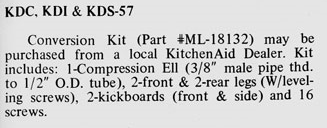frogkid11
Well-known member
Hi everyone,
I am trying to finish restoring my kitchen to its original glory with vintage appliances and need to find the dishwasher. Can anyone tell if this vintage KitchenAid unit can be converted from a roll around to a built-in under counter unit? I do not have room for a stand alone unit so if this cannot be converted, then I need to keep looking - but the price on this unit is really good, it's close by, and is currently being used in very good working order. Thanks for helping me out!!



I am trying to finish restoring my kitchen to its original glory with vintage appliances and need to find the dishwasher. Can anyone tell if this vintage KitchenAid unit can be converted from a roll around to a built-in under counter unit? I do not have room for a stand alone unit so if this cannot be converted, then I need to keep looking - but the price on this unit is really good, it's close by, and is currently being used in very good working order. Thanks for helping me out!!








